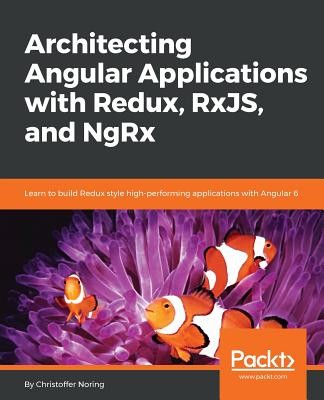
- We will send in 10–14 business days.
- Author: Christoffer Noring
- Publisher: Packt Publishing
- ISBN-10: 1787122409
- ISBN-13: 9781787122406
- Format: 19.1 x 23.5 x 1.9 cm, softcover
- Language: English
- SAVE -10% with code: EXTRA
Architecting Angular Applications with Redux, RxJS, and NgRx (e-book) (used book) | bookbook.eu
Reviews
Description
Manage state in Angular to write high performing web apps by combining the power of Flux, RxJS, and NgRx
Key Features:
- Learn what makes an excellent Angular application architecture
- Use Redux to write performant, consistent Angular applications
- Incorporate Reactive Programming principles and RxJS to make it easier to develop, test, and debug your Angular applications
Book Description:
Managing the state of large-scale web applications is a highly challenging task with the need to align different components, backends, and web workers harmoniously. When it comes to Angular, you can use NgRx, which combines the simplicity of Redux with the reactive programming power of RxJS to build your application architecture, making your code elegant and easy to reason about, debug, and test.
In this book, we start by looking at the different ways of architecting Angular applications and some of the patterns that are involved in it. This will be followed by a discussion on one-way data flow, the Flux pattern, and the origin of Redux.
The book introduces you to declarative programming or, more precisely, functional programming and talks about its advantages. We then move on to the reactive programming paradigm. Reactive programming is a concept heavily used in Angular and is at the core of NgRx. Later, we look at RxJS, as a library and master it. We thoroughly describe how Redux works and how to implement it from scratch. The two last chapters of the book cover everything NgRx has to offer in terms of core functionality and supporting libraries, including how to build a micro implementation of NgRx.
This book will empower you to not only use Redux and NgRx to the fullest, but also feel confident in building your own version, should you need it.
What You Will Learn:
- Understand the one-way data flow and Flux pattern
- Work with functional programming and asynchronous data streams
- Figure out how RxJS can help us address the flaws in promises
- Set up different versions of cascading calls
- Explore advanced operators
- Get familiar with the Redux pattern and its principles
- Test and debug different features of your application
- Build your own lightweight app using Flux, Redux, and NgRx
Who this book is for:
If you have been developing Angular applications and want to dive deeper into the Angular architecture with Redux, RxJS, and NgRx to write robust web apps, then this book is for you.
EXTRA 10 % discount with code: EXTRA
The promotion ends in 16d.12:56:24
The discount code is valid when purchasing from 10 €. Discounts do not stack.
- Author: Christoffer Noring
- Publisher: Packt Publishing
- ISBN-10: 1787122409
- ISBN-13: 9781787122406
- Format: 19.1 x 23.5 x 1.9 cm, softcover
- Language: English English
Manage state in Angular to write high performing web apps by combining the power of Flux, RxJS, and NgRx
Key Features:
- Learn what makes an excellent Angular application architecture
- Use Redux to write performant, consistent Angular applications
- Incorporate Reactive Programming principles and RxJS to make it easier to develop, test, and debug your Angular applications
Book Description:
Managing the state of large-scale web applications is a highly challenging task with the need to align different components, backends, and web workers harmoniously. When it comes to Angular, you can use NgRx, which combines the simplicity of Redux with the reactive programming power of RxJS to build your application architecture, making your code elegant and easy to reason about, debug, and test.
In this book, we start by looking at the different ways of architecting Angular applications and some of the patterns that are involved in it. This will be followed by a discussion on one-way data flow, the Flux pattern, and the origin of Redux.
The book introduces you to declarative programming or, more precisely, functional programming and talks about its advantages. We then move on to the reactive programming paradigm. Reactive programming is a concept heavily used in Angular and is at the core of NgRx. Later, we look at RxJS, as a library and master it. We thoroughly describe how Redux works and how to implement it from scratch. The two last chapters of the book cover everything NgRx has to offer in terms of core functionality and supporting libraries, including how to build a micro implementation of NgRx.
This book will empower you to not only use Redux and NgRx to the fullest, but also feel confident in building your own version, should you need it.
What You Will Learn:
- Understand the one-way data flow and Flux pattern
- Work with functional programming and asynchronous data streams
- Figure out how RxJS can help us address the flaws in promises
- Set up different versions of cascading calls
- Explore advanced operators
- Get familiar with the Redux pattern and its principles
- Test and debug different features of your application
- Build your own lightweight app using Flux, Redux, and NgRx
Who this book is for:
If you have been developing Angular applications and want to dive deeper into the Angular architecture with Redux, RxJS, and NgRx to write robust web apps, then this book is for you.


Reviews